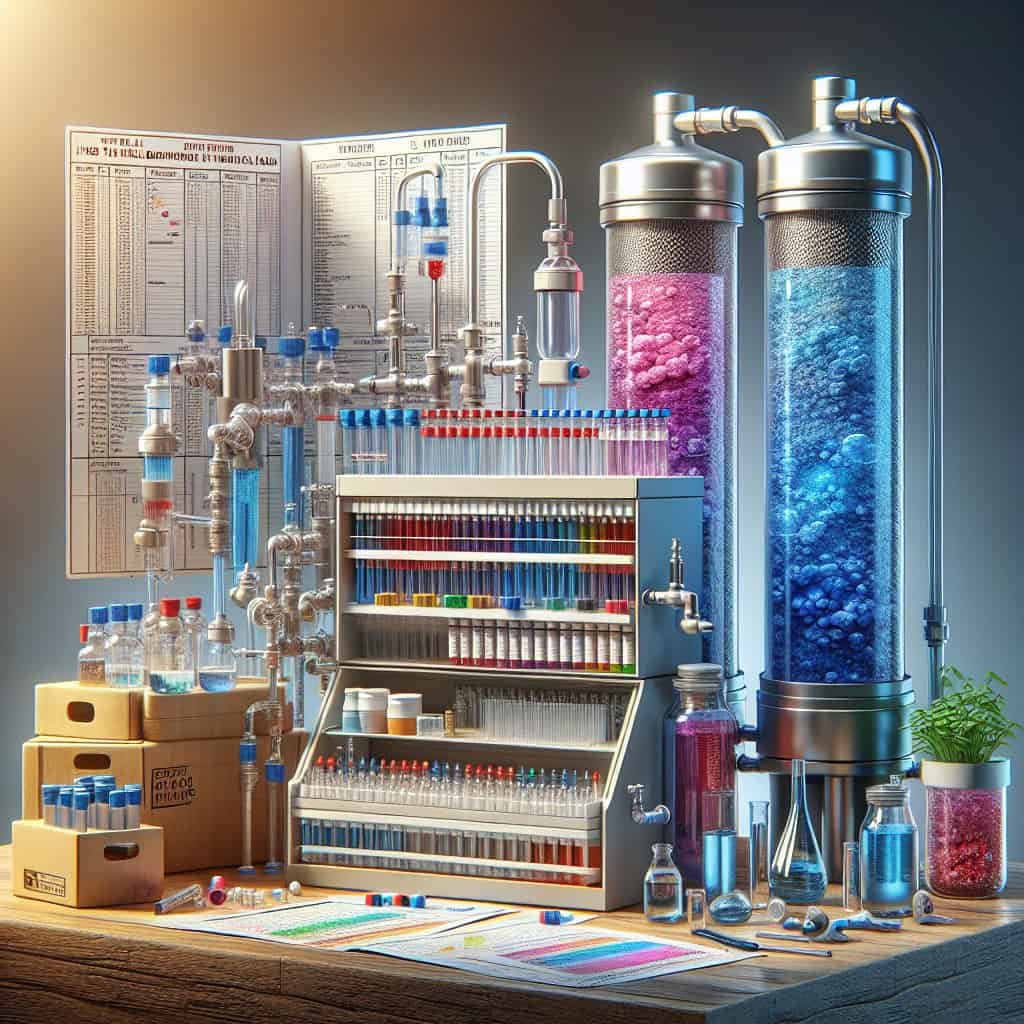If you’re facing the challenge of dealing with well water that has elevated total dissolved solids (TDS), you might find yourself wondering how to tackle this issue. Excess TDS in well water can lead to various problems, such as unpleasant taste, scale buildup, and reduced plumbing efficiency. But fret not! In this article, we will explore the different approaches and solutions available to effectively address elevated TDS in your well water. By the end, you’ll be equipped with the knowledge and guidance to tackle this issue and enjoy better quality water in your home. So let’s delve into the world of well water and discover the solutions that await!

Understanding Total Dissolved Solids (TDS)
Definition of Total Dissolved Solids (TDS)
Total Dissolved Solids (TDS) refers to the combined content of all inorganic and organic substances dissolved in water. These substances can include minerals, salts, metals, and other chemicals. TDS is typically measured in milligrams per liter (mg/L) or parts per million (ppm).
Sources of Total Dissolved Solids in Well Water
Well water can contain elevated levels of TDS due to various sources. Some common sources include natural geological processes, human activities, contaminant infiltration, and agricultural runoff. Understanding the sources of TDS is crucial in identifying the appropriate treatment methods.
Health Implications of Elevated TDS in Drinking Water
While low levels of TDS are generally safe and even beneficial for human health, elevated levels can have adverse effects. The health implications of consuming water with high TDS include increased risk of cardiovascular diseases, kidney problems, and gastrointestinal issues. Therefore, it is essential to test and address elevated TDS levels in well water.
Testing and Measuring Total Dissolved Solids
Importance of Testing TDS Levels
Testing the TDS levels in well water is crucial for determining the water quality and its suitability for various uses, including drinking, cooking, and irrigating. Regular testing allows you to monitor any changes in TDS levels and take necessary actions to maintain water quality.
Methods for Testing TDS
There are several methods available for testing TDS levels in well water. The most common method is using a TDS meter, which measures the electrical conductivity of the water and provides an estimate of the TDS concentration. Another method involves sending water samples to a laboratory for analysis using specialized equipment.
Interpreting TDS Test Results
The interpretation of TDS test results depends on the intended use of the water. Generally, lower TDS levels indicate water of better quality for drinking purposes, but specific TDS guidelines may vary depending on local regulations and standards. It is important to compare the TDS levels with recommended guidelines and consult with water treatment professionals for a more accurate interpretation.
Identifying the Causes of Elevated TDS in Well Water
Naturally Occurring Factors
Naturally occurring factors, such as the geological composition of the surrounding soil and rock formations, can contribute to elevated TDS levels in well water. Areas with naturally high levels of minerals, such as calcium, magnesium, and iron, may have higher TDS concentrations.
Contaminants and Pollutants
Contaminant infiltration from nearby industrial activities, agricultural practices, and faulty septic systems can significantly impact TDS levels in well water. Substances like pesticides, fertilizers, heavy metals, and bacteria can increase the TDS concentration, posing a risk to human health.
Geological Factors
Geological factors, such as the presence of mineral-rich aquifers or underground formations, can influence TDS levels in well water. Water passing through these geological layers can pick up dissolved minerals, resulting in elevated TDS concentrations.
Human Activities
Human activities, including improper waste disposal, chemical spills, and runoff from paved surfaces, can introduce pollutants and increase TDS levels in well water. It is essential to be aware of nearby sources of contamination and take preventive measures to protect well water quality.
Impact of Elevated TDS on Water Quality and Household Applications
Taste and Odor
Water with high TDS levels may have a noticeable taste and odor, often described as salty, bitter, or metallic. These unpleasant qualities can affect the enjoyment of drinking water, cooking, and even the taste of brewed beverages like coffee and tea.
Effect on Plumbing and Appliances
Elevated TDS levels can cause scaling and mineral buildup within plumbing systems and household appliances. This can lead to reduced water flow, clogged pipes, and decreased efficiency of appliances like water heaters, dishwashers, and washing machines.
Gardening and Agricultural Concerns
High TDS levels can adversely affect plants and agricultural activities. Excessive salts and minerals in the water can hinder nutrient absorption by plants, leading to stunted growth, wilted leaves, and reduced crop yields. Irrigation with water containing elevated TDS can also cause soil salinity and negatively impact soil fertility.

Methods to Reduce TDS in Well Water
Water Softening Systems
Water softening systems, typically using ion exchange resin, can effectively reduce TDS levels by removing hardness-causing minerals like calcium and magnesium. These systems replace the minerals with sodium or potassium ions, resulting in softer water with reduced TDS.
Reverse Osmosis (RO)
Reverse osmosis (RO) systems utilize a semi-permeable membrane to remove a wide range of dissolved solids, including TDS. This process forces water through the membrane under pressure, leaving behind the dissolved solids and producing purified water with lower TDS levels.
Distillation
Distillation involves heating the water to create steam, which is then condensed and collected as purified water. This process effectively removes TDS, as the dissolved solids do not vaporize and are left behind in the original water source.
Deionization
Deionization systems use ion-exchange resins to remove both organic and inorganic ions, including TDS, from water. The resins attract and replace ions in the water, resulting in demineralized water with reduced TDS levels.
Electrodialysis
Electrodialysis employs an electric field to separate ions and dissolved solids from water. This process ensures that water passes through selective membranes, effectively reducing TDS concentrations.
Ion Exchange Resins
Ion exchange resins can remove specific ions, including those contributing to elevated TDS levels. These resins attract the ions and replace them with less harmful ones, resulting in water with reduced TDS.
Blending with Low TDS Water
Blending high TDS well water with low TDS water from alternative sources, such as rainwater collection systems or municipal supplies, can help achieve a more desirable TDS concentration. This method allows for customizing the TDS levels to meet specific needs.
Water Filtration
Water filtration systems, such as activated carbon filters or sediment filters, may not directly reduce TDS levels. However, they can effectively remove suspended particles, sediments, and certain contaminants, which can contribute to elevated TDS levels indirectly.
Choosing the Right Treatment Method
Consideration of Water Quality and TDS Levels
When choosing a treatment method for addressing elevated TDS, it is crucial to consider the overall water quality and the specific TDS levels. Different treatment methods are more effective for specific types of contaminants and TDS concentrations. Therefore, a comprehensive water analysis is recommended to determine the most suitable treatment approach.
Budget and Maintenance
Treatment methods vary in cost, maintenance requirements, and operational complexity. It is important to assess your budget and ongoing maintenance capabilities to select a treatment method that aligns with your financial resources and time commitment.
Effectiveness and Efficiency
Each treatment method has its own set of advantages and limitations. Evaluating the effectiveness and efficiency of different treatment methods in reducing TDS is essential. Consider factors such as treatment capacity, water waste, and energy requirements to determine the most efficient and sustainable option.

Maintenance and Monitoring of Treated Water
Regular Testing
Even after implementing a treatment method, regular testing of the treated water is essential to ensure ongoing effectiveness and safety. Regular monitoring allows you to detect any changes in TDS levels and promptly address any potential issues.
Replacing Filters and Components
If your chosen treatment method involves filtration systems or replaceable components, it is important to follow the manufacturer’s recommendations for filter replacement or maintenance. Regularly replacing filters and components ensures optimal performance and helps maintain desired TDS levels.
Professional Servicing
Some treatment systems may require periodic professional servicing or maintenance to ensure their continued effectiveness. Consulting with water treatment professionals and following their recommended servicing schedules can prolong the lifespan of your treatment system and provide peace of mind.
Additional Considerations for Well Water Treatment
Preventing TDS Buildup
While treating elevated TDS levels is crucial, preventing TDS buildup in the first place is equally important. Implementing best practices for water source protection, such as proper waste disposal, regular septic tank maintenance, and managing agricultural runoff, can help reduce the risk of TDS contamination.
Protecting Well from Contaminants
To maintain overall water quality and lower TDS levels, it is important to protect your well from potential contaminants. Regularly inspect and maintain the well structure, properly seal and secure the wellhead, and ensure proper monitoring and testing of the water source to identify any potential issues early on.
Environmental Impact and Sustainability
When choosing a treatment method for addressing elevated TDS, it is essential to consider the environmental impact and sustainability of the chosen approach. Opting for methods that minimize water waste, energy consumption, and the use of harmful chemicals can contribute to a more sustainable water treatment solution.

Contacting Water Treatment Professionals
Benefits of Seeking Professional Help
Seeking the expertise of water treatment professionals can provide numerous benefits. They have the knowledge and experience to assess your specific water needs, recommend suitable treatment methods, and ensure effective implementation. Professional help ensures that your water treatment system is tailored to your unique requirements and provides the desired results.
Finding an Experienced Water Treatment Provider
When searching for a water treatment provider, it is important to look for experienced professionals with a proven track record. Seek recommendations from trusted sources, check for certifications or licensing, and read customer reviews to find a reputable and reliable water treatment provider.
Consultation and Assessment
Once you have identified potential water treatment providers, schedule a consultation and assessment. During this process, the professionals will evaluate your well water quality, assess TDS levels, and recommend appropriate treatment methods based on your specific needs and budget.
Conclusion
Addressing elevated Total Dissolved Solids (TDS) in well water is crucial for ensuring safe and high-quality water for various household purposes. By understanding the sources and causes of TDS, testing and monitoring TDS levels, and implementing suitable treatment methods, you can effectively manage and reduce the TDS concentration in your well water. Consultation with water treatment professionals and regular maintenance are key to achieving sustainable and optimal water quality, protecting your health and the environment.


